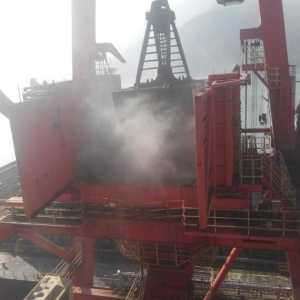


(Posted on 11/11/20)
After years of success in Asian-built ships, DESMI is now bringing its efficient firefighting products to the European market. In marine applications, DESMI’s FineFog Fixed Water-Based Firefighting systems offer a safe, low-pressure alternative.
In Asia, DESMI is known not only for its pumps but also for its firefighting systems. More than 180 such systems are supplied to ship owners around the globe – though most of these are for ships built in China. There have not been so many installations in European shipyards, so DESMI’s Marine and Offshore Sales Manager, Christian Mellergaard wants to reach out to European ship owners and shipyards to change this.
“They mainly know us for our pumps and might not know we offer these highly efficient firefighting systems – which of course include our pumps and offer some great advantages,” he says.
DESMI has the following types of firefighting systems available:
• Fixed water-based local application system for machinery space
• Equivalent water mist fire extinguishing system for total flooding in machinery spaces and
cargo pump rooms
• Water sprinkler system for accommodation
• Deck foam system for oil/chemical tanker deck protection
• Foam system for deck and helicopter landing areas
• Water spray/deluge/drencher system for special category spaces.
For machinery spaces, DESMI offers its low-pressure, water-based FineFog system. FineFog dispenses a mist – like a fog. “You can kill the fire much easier with mist than by just pouring water on it. These millions of small droplets absorb much more heat, and oxygen is displaced locally at fire source. As a result, an inerting effect is generated, effectively killing the fire,” Christian says.
Ships will benefit from the automatic system around high-risk objects like combustion machinery, oil-fired boilers or burners, incinerators or purifiers for heated oil fuel. If there is an oil spill that catches fire, then the FineFog nozzles above that application are activated – based on a signal from flame detector or smoke detector – and the alarm sounds. The crew can still enter the room and continue with conventional firefighting with hoses. Or, if necessary, they can release the totalflooding mechanism in engine rooms up to 5036 m.
“And that's where our system has a big advantage over gas-based firefighting systems like CO2,” Christian says. While CO2 systems are effective, they come with a risk to human life. “With CO2, if you have a fire on your engine room, you first need to evacuate everybody because otherwise the gas will suffocate them. And you have to make sure ventilation is shut off, and the room is completely sealed off. You must also ensure that all machinery in the engine room is stopped. This can take several minutes. In this time, a minor fire can grow quite large,” he says. “You only have one shot with CO2 –you can only release the
fire could reignite very easily. And afterward, you can’t go into the engine room or confined space for several hours. You need to be totally sure that the fire is put out first before restarting ventilation of the engine room.”
Alfa Laval has completed the acquisition of UK-based NRG Marine, a leading provider of ultrasonic anti... Read more
In a landmark moment for the global maritime industry, the Maritime Battery Forum (MBF) and the Zero... Read more
Bruks Siwertell Group has announced a leadership transition as Peter Jonsson steps down as CEO after... Read more
ClassNK has issued an approval in principle (AiP) for a Rigid Windsail Type Wind-Assisted Propulsion... Read more
Elcome International’s new high-speed internet service, WELCOME, is revolutionising the way ship... Read more
Kaiko Systems, a leader in AI-driven frontline intelligence for the maritime industry, today announced... Read more
Marcegaglia’s latest acquisition, the LHM 600, marks a significant milestone as the 2,000th mobile... Read more
The Isle of Man Ship Registry (IOMSR) is playing a key role in the development of a high-tech sail aimed... Read more
AtoB@C Shipping, subsidiary of ESL Shipping, has taken delivery of Terramar in Goa, India on 14 March... Read more
As a new strategy period commences, VIKING Life-Saving Equipment A/S has achieved strong financial results... Read more